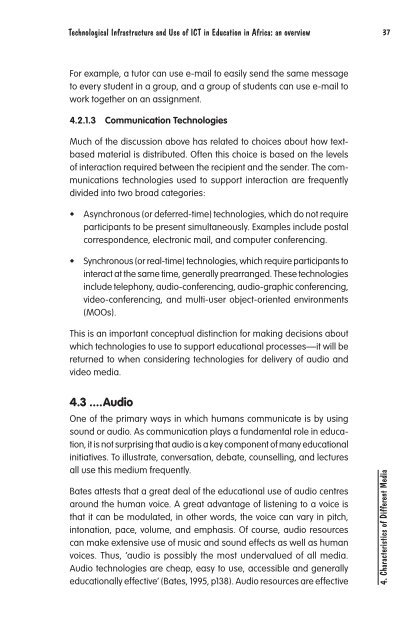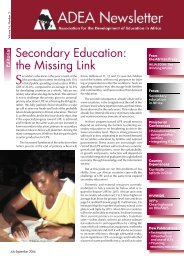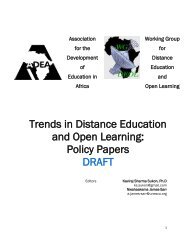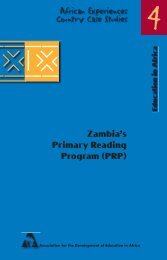Technological Infrastructure and Use of ICT in Education in ... - ADEA
Technological Infrastructure and Use of ICT in Education in ... - ADEA
Technological Infrastructure and Use of ICT in Education in ... - ADEA
Create successful ePaper yourself
Turn your PDF publications into a flip-book with our unique Google optimized e-Paper software.
<strong>Technological</strong> <strong>Infrastructure</strong> <strong>and</strong> <strong>Use</strong> <strong>of</strong> <strong>ICT</strong> <strong>in</strong> <strong>Education</strong> <strong>in</strong> Africa: an overview<br />
37<br />
For example, a tutor can use e-mail to easily send the same message<br />
to every student <strong>in</strong> a group, <strong>and</strong> a group <strong>of</strong> students can use e-mail to<br />
work together on an assignment.<br />
4.2.1.3 Communication Technologies<br />
Much <strong>of</strong> the discussion above has related to choices about how textbased<br />
material is distributed. Often this choice is based on the levels<br />
<strong>of</strong> <strong>in</strong>teraction required between the recipient <strong>and</strong> the sender. The communications<br />
technologies used to support <strong>in</strong>teraction are frequently<br />
divided <strong>in</strong>to two broad categories:<br />
• Asynchronous (or deferred-time) technologies, which do not require<br />
participants to be present simultaneously. Examples <strong>in</strong>clude postal<br />
correspondence, electronic mail, <strong>and</strong> computer conferenc<strong>in</strong>g.<br />
• Synchronous (or real-time) technologies, which require participants to<br />
<strong>in</strong>teract at the same time, generally prearranged. These technologies<br />
<strong>in</strong>clude telephony, audio-conferenc<strong>in</strong>g, audio-graphic conferenc<strong>in</strong>g,<br />
video-conferenc<strong>in</strong>g, <strong>and</strong> multi-user object-oriented environments<br />
(MOOs).<br />
This is an important conceptual dist<strong>in</strong>ction for mak<strong>in</strong>g decisions about<br />
which technologies to use to support educational processes—it will be<br />
returned to when consider<strong>in</strong>g technologies for delivery <strong>of</strong> audio <strong>and</strong><br />
video media.<br />
4.3 ....Audio<br />
One <strong>of</strong> the primary ways <strong>in</strong> which humans communicate is by us<strong>in</strong>g<br />
sound or audio. As communication plays a fundamental role <strong>in</strong> education,<br />
it is not surpris<strong>in</strong>g that audio is a key component <strong>of</strong> many educational<br />
<strong>in</strong>itiatives. To illustrate, conversation, debate, counsell<strong>in</strong>g, <strong>and</strong> lectures<br />
all use this medium frequently.<br />
Bates attests that a great deal <strong>of</strong> the educational use <strong>of</strong> audio centres<br />
around the human voice. A great advantage <strong>of</strong> listen<strong>in</strong>g to a voice is<br />
that it can be modulated, <strong>in</strong> other words, the voice can vary <strong>in</strong> pitch,<br />
<strong>in</strong>tonation, pace, volume, <strong>and</strong> emphasis. Of course, audio resources<br />
can make extensive use <strong>of</strong> music <strong>and</strong> sound effects as well as human<br />
voices. Thus, ‘audio is possibly the most undervalued <strong>of</strong> all media.<br />
Audio technologies are cheap, easy to use, accessible <strong>and</strong> generally<br />
educationally effective’ (Bates, 1995, p138). Audio resources are effective<br />
4. Characteristics <strong>of</strong> Different Media

















